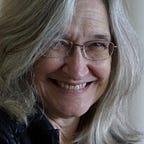One foot in front of the other
What do you do on a day when you wake to discover that your country has lost its moral compass?
You go back to bed. It was 10:30 on election night at home in Seattle — but 4:30 the next morning where we were in Spain. The tally looked grim. I hoped things would change if I went back to sleep. I didn’t sleep.
By 5:30 we were both awake, coffee in hand, watching the results unfold. At 6:30 we turned off the news in shock. We went back to bed, lacking the will to do anything else. We didn’t sleep.
Then, there was nothing to do but get up and put one foot in front of another.
We walked. We started in the neighborhood we spent the past two days learning to love — a neighborhood in Seville named Triana. It’s just across the Guadalquiver River from downtown — lively, lined with restaurants, overflowing with people, full of art and flamenco. It’s been a center for ceramic production for hundreds of years, so its covered with colorful tiles. They decorate the buildings…
Colorful tiles honor Triana’s people… advertise stores… and welcome folks home.
But Triana has a darker side too. We discovered it at the museum of the Castillo San Jorge, the ruins of which are right by the bridge from downtown Seville. Triana was headquarters for the Spanish Inquisition, and its story is told vividly in the museum — of the powerlessness of the victims, the procedures and torture and death, the power and greed that motivated accusers. We were stunned to realize the Inquisition lasted 300 years — but grateful that Triana is willing to own its story and share it, the bad with the good.
Today when we walked, we passed the Castillo and crossed the river back to Santa Cruz, where we stayed while we visited Seville’s more famous monuments. Santa Cruz is still known as the Jewish Quarter, despite the fact that the Jewish community was driven out 600 years ago. Many who converted instead of leaving disappeared into the Castillo San Jorge, the Inquisition headquarters in Triana. Countries do have their dark times.
We revisited the narrow streets and pocket plazas of Santa Cruz, this time recognizing the tilework of Triana all over Seville. Winding through streets tinged by harsh history, we recognized that Spain, like America, has had its moments of both horror and genius.
We walked through the vibrancy of Seville, past gardens, down lanes, through alleyways, and along the river. We took pictures — of colorful storefronts, welcoming entry ways, and the Plaza de Espanol — Spain at its best not its worst.
We put one foot in front of the other until we were too tired to walk and turned for home in Triana. One foot in front of the other, as we’re going to have to do tomorrow too. To acknowledge that something’s gone terribly wrong, but remember the people at home that we love, the best we know we can be. And to look for the next step.
